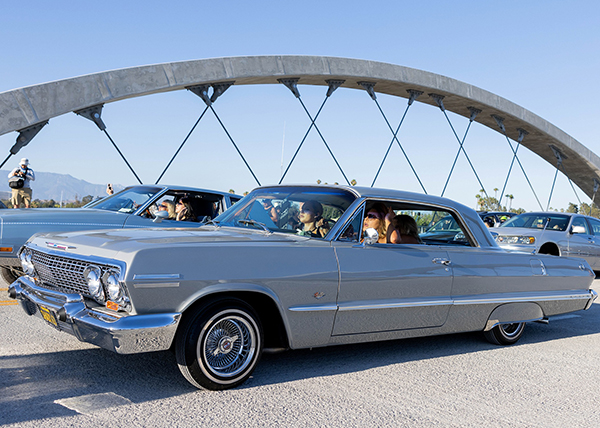Wave Wire Services
LOS ANGELES — The Sixth Street Viaduct, connecting Boyle Heights and the downtown Arts District and replacing one of the city’s most iconic structures, officially opened July 10, the third consecutive day of community celebrations.
“It is in many ways the embodiment of what Los Angeles strives to be — a city that connects community, the cultural capital of the world,” Mayor Eric Garcetti said July 8.
Festivities began July 8 with local dignitaries commemorating completion of the roughly $588 million viaduct — the largest bridge project in the city’s history with a formal ribbon-cutting ceremony followed by an arch-lighting ceremony.
Activities July 9 included live music from Ozomatli, along with food trucks, a vintage car display, fireworks and a bridge-lighting ceremony.
The opening celebration culminated July 10 with the bridge open to pedestrian and bicycle traffic only from 11 a.m. to 4 p.m. At 7 p.m., the bridge officially opened to vehicular traffic.
The project took years longer than anticipated and the final cost is well above original estimates.
It was funded by the Federal Highway Transportation Administration, the state Department of Transportation and the city of Los Angeles. The project included the largest number of women workers of any public works development in the nation.
The previous Sixth Street Viaduct, which was built in 1932, was a Los Angeles landmark seen in countless films and television shows, most notably “Grease” and “Terminator 2: Judgment Day.”
But that original structure fell victim to the ravages of time and deterioration blamed on an alkali-silica chemical reaction that caused an expansion and cracking of the concrete over time, leaving the bridge seismically unsound.
Demolition work on the original structure began in 2016, with city officials at the time projecting a 2019 completion for the then-$449 million project. Within a few months, however, the completion date was pushed back to late 2020, followed by additional construction delays during the ensuing COVID-19-plagued years.
The new viaduct’s “Ribbon of Light” design, with its 20 sweeping arches, was created by the architectural firm HNTB Corp. and Los Angeles-based architect Michael Maltzan.
City Engineer Gary Lee Moore said the new bridge is seismically strong, unlike its predecessor.
“We came back with something bigger and better,” he told ABC7. “And the other thing is, during an earthquake, this is the place to be. It can withstand a 1,000-year seismic event. Of course, I hope there’s no seismic event, but if there is, this is going to be a very safe place.”
“After more than six years of being closed, we are excited to reopen the newly built Sixth Street Viaduct and usher in a new era for Los Angeles,” said City Councilman Kevin de León, who called the bridge “one of the most inspiring public works projects in our city’s history.”
“The Sixth Street Viaduct is a shining example of collaboration between members of the community and officials at all levels of government,” said U.S. Rep. Jimmy Gomez.
The city’s Bureau of Engineering plans to create a 12-acre park under the bridge to provide access to the L.A. River, public art, recreational programming and more.
According to the Bureau of Engineering’s plans, the downtown side of the Sixth Street Viaduct park will include a rain garden, planted seating area, a play and performance lawn, a sculpture garden, a meadow, a dog play area, an adult fitness section, cafe and restrooms, a sloped river gateway, an urban forest and terraces.
On the Boyle Heights side, the park’s plans include a skateboard area, meadow, a picnic area, a synthetic turf soccer field, flexible courts sized for basketball, futsal and volleyball, a play and performance lawn; a children’s play area, a promenade, a landscaped seating area, an adult fitness area, a rain garden, a dog play area and grilling spaces.
“With the addition of bike lanes, friendly pedestrian access and a new upcoming park in 2023, we have a new community staple that not only modernizes the bridge but improves community access by connecting the heart of my district from Boyle Heights to the Arts District of downtown Los Angeles,” Assemblyman Miguel Santiago added.












